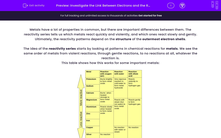Metals have a lot of properties in common, but there are important differences between them. The reactivity series tells us which metals react quickly and violently, and which ones react slowly and gently.
Ultimately, the reactivity patterns depend on the structure of the outermost electron shells.
The idea of the reactivity series starts by looking at patterns in chemical reactions for metals. We see the same order of metals from violent reactions, through gentle reactions, to no reactions at all, whatever the reaction is.
This table shows how this works for some important metals:
.jpg)
Some people like to use a mnemonic to remember the order.
You could use: Please Stop Calling Me A Zebra I Collect Smart Goats but you don't have to!
Displacement reactions and the reactivity series
This picture shows what happens when you put a piece of zinc (a grey metal) into a solution of copper sulfate (a blue solution):

The brown metal forming in the beaker is copper because a chemical reaction has happened:
CuSO4 (aq) + Zn (s) → ZnSO4 (aq) + Cu (s)
Zinc has replaced copper in the compound, leaving the copper to form metal atoms. This kind of reaction is called a displacement reaction because the zinc has displaced (or pushed) the copper from the compound.
The rule linking displacement reactions and the reactivity series is: The more reactive metal goes in the compound, and the less reactive metal stays as a metal.
So if you put aluminium in copper sulfate solution, this reaction happens:
copper sulfate + aluminium → aluminium sulfate + copper (aluminium is more reactive than copper, so it goes into the compound)
If you put iron in magnesium nitrate solution, no reaction happens:
magnesium nitrate + iron → magnesium nitrate + iron (magnesium is more reactive than iron, so it stays in the compound)
By trying lots of reactions like this, and noting which metals can make a reaction happen, we can sort metals into the reactivity series.
The more reactions the metal does, the more reactive it is.
Electrons, displacement reactions and the reactivity series
Let's think about copper sulfate + zinc again. In copper sulfate, the copper is a Cu2+ ion. The sulfate ion (SO4) is negatively charged, (SO4)2-.
Metallic zinc is neutral zinc atoms, held together by metallic bonding.
After the reaction, we have zinc sulfate - that consists of Zn2+ ions and (SO4)2- ions. The copper is neutral metallic copper.
In other words, the zinc has lost electrons, and the copper has gained electrons. We can write this as a pair of ionic equations;
Copper: Cu2+ + 2e- → Cu
Zinc: Zn → Zn2+ + 2e-
The metal which loses electrons is said to be oxidised; the metal which gains electrons is said to be reduced. The reason why these names make sense will come in another activity.
This gives us another way to think about more and less reactive metals.
All metals are more stable if they can lose electrons to become positive ions. The more reactive a metal is, the more it is able to force its excess electrons onto another atom.
This helps us to understand why the reactivity series is in the order it is.
The most reactive metals are in Group 1 - one outermost electron is easy for alkali metals to lose. The next most reactive metals are in Group 2 with two outermost electrons.
After this, the pattern becomes more complicated, but the reactivity series is all about the electrons.
Time for some questions on this now.







